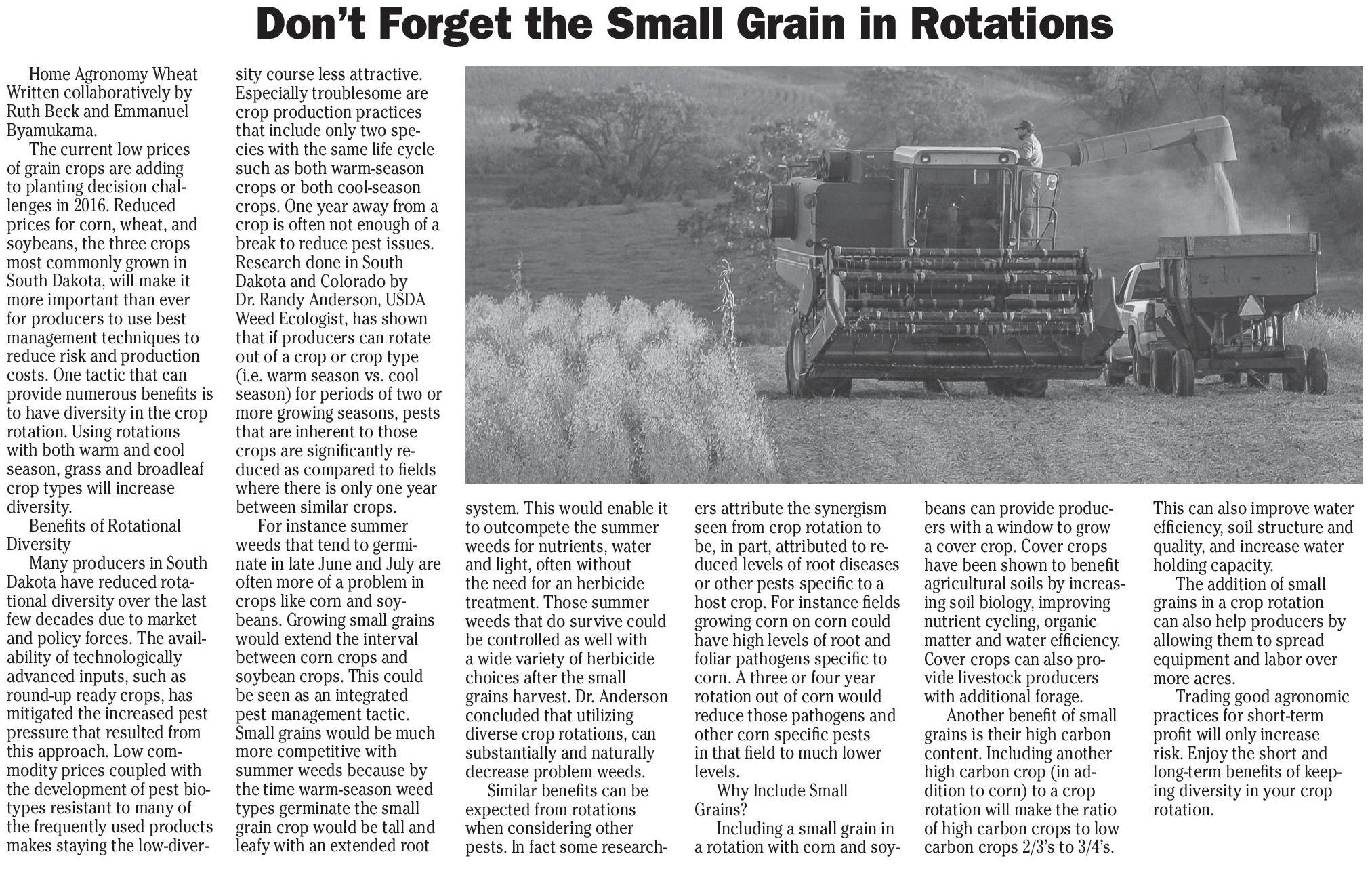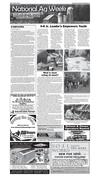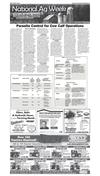16






March 15, 2016 • Page 16
shop online at www.missourivalleyshopper.com
National Ag Week
March 13-19, 2016
Don’t Forget the Small Grain in Rotations
Home Agronomy Wheat
Written collaboratively by
Ruth Beck and Emmanuel
Byamukama.
The current low prices
of grain crops are adding
to planting decision challenges in 2016. Reduced
prices for corn, wheat, and
soybeans, the three crops
most commonly grown in
South Dakota, will make it
more important than ever
for producers to use best
management techniques to
reduce risk and production
costs. One tactic that can
provide numerous benefits is
to have diversity in the crop
rotation. Using rotations
with both warm and cool
season, grass and broadleaf
crop types will increase
diversity.
Benefits of Rotational
Diversity
Many producers in South
Dakota have reduced rotational diversity over the last
few decades due to market
and policy forces. The availability of technologically
advanced inputs, such as
round-up ready crops, has
mitigated the increased pest
pressure that resulted from
this approach. Low commodity prices coupled with
the development of pest biotypes resistant to many of
the frequently used products
makes staying the low-diver-
sity course less attractive.
Especially troublesome are
crop production practices
that include only two species with the same life cycle
such as both warm-season
crops or both cool-season
crops. One year away from a
crop is often not enough of a
break to reduce pest issues.
Research done in South
Dakota and Colorado by
Dr. Randy Anderson, USDA
Weed Ecologist, has shown
that if producers can rotate
out of a crop or crop type
(i.e. warm season vs. cool
season) for periods of two or
more growing seasons, pests
that are inherent to those
crops are significantly reduced as compared to fields
where there is only one year
between similar crops.
For instance summer
weeds that tend to germinate in late June and July are
often more of a problem in
crops like corn and soybeans. Growing small grains
would extend the interval
between corn crops and
soybean crops. This could
be seen as an integrated
pest management tactic.
Small grains would be much
more competitive with
summer weeds because by
the time warm-season weed
types germinate the small
grain crop would be tall and
leafy with an extended root
system. This would enable it
to outcompete the summer
weeds for nutrients, water
and light, often without
the need for an herbicide
treatment. Those summer
weeds that do survive could
be controlled as well with
a wide variety of herbicide
choices after the small
grains harvest. Dr. Anderson
concluded that utilizing
diverse crop rotations, can
substantially and naturally
decrease problem weeds.
Similar benefits can be
expected from rotations
when considering other
pests. In fact some research-
ers attribute the synergism
seen from crop rotation to
be, in part, attributed to reduced levels of root diseases
or other pests specific to a
host crop. For instance fields
growing corn on corn could
have high levels of root and
foliar pathogens specific to
corn. A three or four year
rotation out of corn would
reduce those pathogens and
other corn specific pests
in that field to much lower
levels.
Why Include Small
Grains?
Including a small grain in
a rotation with corn and soy-
beans can provide producers with a window to grow
a cover crop. Cover crops
have been shown to benefit
agricultural soils by increasing soil biology, improving
nutrient cycling, organic
matter and water efficiency.
Cover crops can also provide livestock producers
with additional forage.
Another benefit of small
grains is their high carbon
content. Including another
high carbon crop (in addition to corn) to a crop
rotation will make the ratio
of high carbon crops to low
carbon crops 2/3’s to 3/4’s.
This can also improve water
efficiency, soil structure and
quality, and increase water
holding capacity.
The addition of small
grains in a crop rotation
can also help producers by
allowing them to spread
equipment and labor over
more acres.
Trading good agronomic
practices for short-term
profit will only increase
risk. Enjoy the short and
long-term benefits of keeping diversity in your crop
rotation.
Beef is a Nutrition Powerhouse
Re-Invest in Your Operation
with
Brock Grain Bins & Lester Buildings
Lean beef is a nutrition
powerhouse. It is a naturally
nutrient-rich food providing
10 essential nutrients with
only about 150 calories per
3-ounce serving. Lean beef
packs more nutrients per
bite with fewer calories, so
it’s easier on the waistline
than empty-calorie foods.
Meeting the new 2015-2020
Dietary Guidelines and MyPlate recommendations, lean
beef is a great addition to a
plate full of fruits, vegetables
and whole grains.
Here are just a few of the
many “hidden” nutrients
in lean beef, along with the
multiple body benefits they
provide:
Protein: A 3-ounce
serving of beef provides 25
grams of protein which is
about 50% of your recommended Daily Value (DV). It
plays a major role in muscle
maintenance, weight management and prevention of
chronic diseases.
Selenium: As an excellent source of selenium,
one 3-ounce serving of beef
provides 40 percent of your
daily needs. It provides antioxidant benefits, as well as
enhancing the body’s ability
to fight infections.
Choline: As an essential
nutrient for humans, choline
plays a vital role in cognition
and long- and short-term
memory functions. Beef
provides 16 percent of the
DV for choline.
Zinc: Beef provides 36
percent of the DV for zinc.
Zinc is essential for proper
growth and health and also
plays a key role in building muscles and healing
wounds.
Iron: Iron helps carry
oxygen in the blood to all
cells and muscles to prevent
fatigue. To get the same
amount of iron in a 3-ounce
serving of beef, you would
need to eat an equivalent of
three cups of raw spinach!
Vitamin B12: Essential
for proper brain and nervous
system function, vitamin B12
is only naturally available
from animal foods. Beef is an
excellent source, providing
44 percent of the DV.
Besides tasting great, you
can feel good about loving
beef. Lean beef provides a
simple and delicious way to
meet the daily recommendations of several nutrients. It
gives you the power to feel
full longer, stay active longer
and manage your weight. It’s
a great feeling to know that
the food you crave is good
for you too.
For more information and
beef recipes, check out the
South Dakota Beef Council.
In addition, see UNL Extension’s Easy Ground Beef
Recipes From Your Freezer
for quick, healthy meals in
a hurry
HUBBS AGENCY, INC.
PINKELMAN SALES, INC.
Hartington, NE
402-254-6529
www.pinkelmansales.com
gpinkelman@hartel.net
Insurance Matters
When it comes to insuring your family’s security,
the right agent makes all the difference. Make sure
you have the quality coverage your family needs by
contacting me today for a free, no-obligation policy
review and rate quote.
1201 W. 2nd St. • Crofton, NE
402-388-4772
www.tcicrofton.com
Home • Farm • Auto • Crop
• Truck • Commercial
Licensed in Nebraska and South Dakota
Ryan R. Loecker
Town & Country Insurance
1-800-535-3378
“The Crop Insurance Specialists”
Ph. 877-260-5126 or 605-260-5126
Fax 605-260-5128 • Yankton, SD
Agriculture.... Planting the seeds of success.
ank
h
T
WE DO
ALL GLASS!
You
FARMERS!
RON’S AUTO GLASS
REAL ESTATE
RENTALS
AUTOMOTIVE
EMPLOYMENT
MERCHANDISE
COUPONS
the Missouri Valley
Shopper and
missourivalleyshopper.com
is your complete source
for buying and selling.
Everything you need
is just a click or call away!
Place an ad today by calling
1915 Broadway
Yankton, SD
605-665-9841
605.665.5584
MV Shopper
M I S S O U R I VA L L EY































 Previous Page
Previous Page





